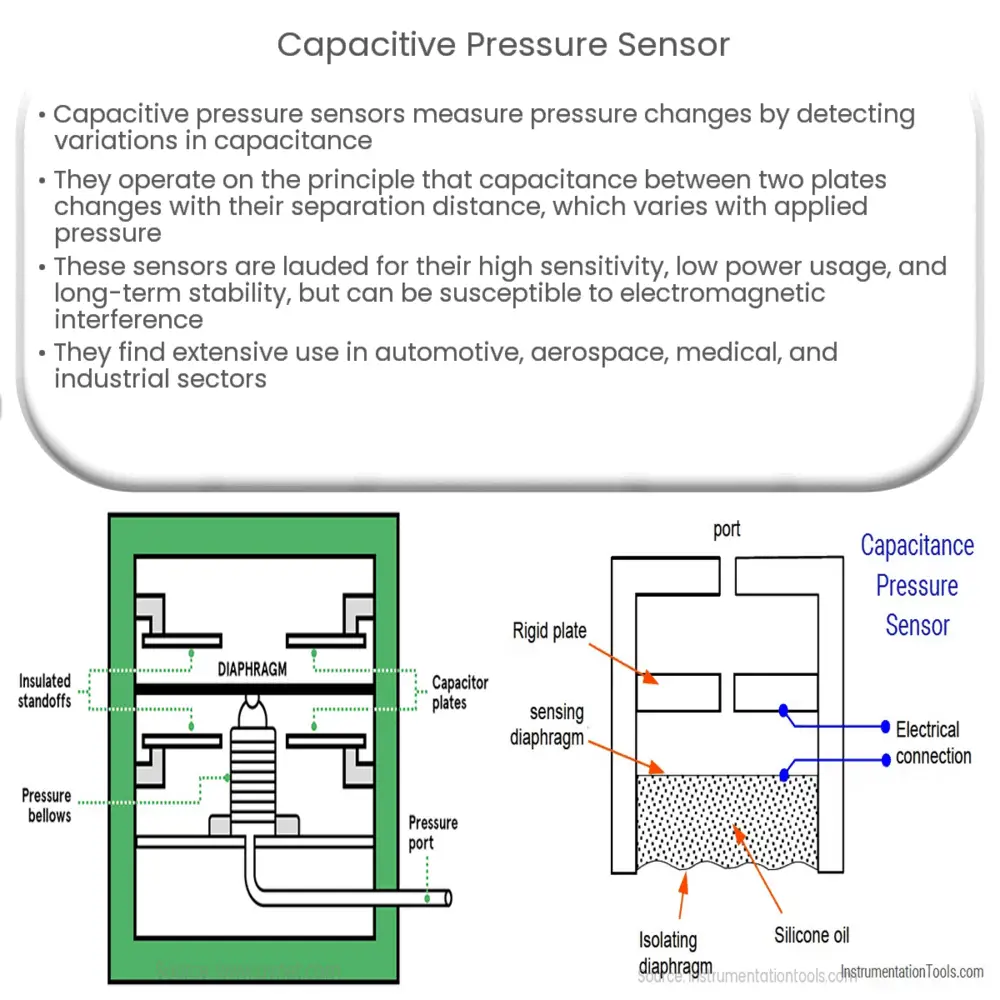Capacitive pressure sensors measure pressure changes by detecting capacitance variations, offering high sensitivity and stability for diverse applications.

Capacitive Pressure Sensor: An Overview
Introduction to Capacitive Pressure Sensors
Capacitive pressure sensors are devices that measure pressure changes by detecting the variation in capacitance, which is the ability of a system to store an electric charge. Capacitive pressure sensors are widely used in various applications, including automotive, aerospace, medical, and industrial sectors, due to their high sensitivity, low power consumption, and excellent long-term stability.
Working Principle of Capacitive Pressure Sensors
Capacitive pressure sensors are based on the principle that the capacitance between two parallel plates is inversely proportional to their separation distance. When pressure is applied to a flexible diaphragm, one of the plates, it causes the diaphragm to deflect, altering the distance between the two plates and consequently changing the capacitance value. This change in capacitance can be measured and calibrated to represent the pressure exerted on the sensor.
Key Components of Capacitive Pressure Sensors
Capacitive pressure sensors consist of several main components, which include:
- Diaphragm: A flexible membrane that deflects under applied pressure, causing a change in the distance between the two parallel plates. Diaphragms can be made from various materials, such as silicon, metal, or polymer, depending on the application requirements.
- Electrodes: Conductive plates that form the capacitor. One plate is fixed, while the other is attached to the diaphragm. These electrodes can be made from materials like gold, platinum, or aluminum, depending on the desired performance and compatibility with the intended environment.
- Insulating Layer: A thin layer of insulating material, typically silicon dioxide or silicon nitride, is placed between the electrodes to prevent electrical shorting and maintain a stable capacitance value.
- Electronic Circuitry: The electronic circuitry is responsible for measuring the changes in capacitance and converting them into an electrical signal that can be easily interpreted by a microcontroller or other data acquisition system.
Advantages and Disadvantages of Capacitive Pressure Sensors
Capacitive pressure sensors offer several advantages over other types of pressure sensing technologies, such as piezoresistive or optical sensors. Some of the key benefits include:
- High sensitivity, allowing for the detection of small pressure changes
- Low power consumption, making them suitable for battery-powered applications
- Excellent long-term stability and low hysteresis
- Minimal temperature dependence, enabling reliable performance over a wide temperature range
Despite these advantages, capacitive pressure sensors also have some limitations. For example, they can be susceptible to external electromagnetic interference, which may affect the accuracy of the sensor readings. Additionally, capacitive sensors typically require more complex signal conditioning circuitry compared to other pressure sensing technologies, which can increase the overall cost and complexity of the system.
Applications of Capacitive Pressure Sensors
Capacitive pressure sensors are used in a wide range of applications across various industries. Some of the common applications include:
- Automotive: In the automotive sector, capacitive pressure sensors are employed for monitoring tire pressure, fuel tank pressure, and manifold pressure, among other parameters.
- Aerospace: Capacitive pressure sensors are utilized in altitude measurement, cabin pressure monitoring, and flight control systems in the aerospace industry.
- Medical: Medical applications of capacitive pressure sensors include blood pressure monitoring, respiratory monitoring, and infusion pumps.
- Industrial: In industrial settings, capacitive pressure sensors are used for process control, leak detection, and hydraulic systems monitoring.
Design Considerations for Capacitive Pressure Sensors
When designing a capacitive pressure sensor, several factors must be taken into consideration to ensure optimal performance and reliability. These factors include:
- Material Selection: The choice of materials for the diaphragm, electrodes, and insulating layer is crucial for achieving the desired sensor performance, as well as compatibility with the intended environment and application.
- Diaphragm Design: The diaphragm’s thickness, shape, and size significantly impact the sensor’s sensitivity, linearity, and hysteresis. A thinner diaphragm generally results in higher sensitivity but may be more susceptible to mechanical stress and deformation.
- Electrode Geometry: The electrode geometry affects the sensor’s capacitance, sensitivity, and linearity. Designers must carefully consider the electrode’s shape and size to achieve the desired performance characteristics.
- Temperature Compensation: Since capacitive pressure sensors can be affected by temperature variations, incorporating temperature compensation techniques in the electronic circuitry is essential for maintaining accurate and stable sensor readings over a wide temperature range.
- Electromagnetic Interference (EMI) Protection: To minimize the impact of external EMI on sensor readings, proper shielding and filtering techniques should be implemented in the sensor design and electronic circuitry.
Conclusion
Capacitive pressure sensors are versatile devices that offer high sensitivity, low power consumption, and excellent long-term stability, making them suitable for a wide range of applications across various industries. By carefully considering the design factors such as material selection, diaphragm design, electrode geometry, temperature compensation, and EMI protection, engineers can develop capacitive pressure sensors that meet the specific requirements of their applications and provide accurate, reliable performance in diverse environments.

